Though nearly all our land is used for wildlife, we do have a vegetable garden. Twenty-something years ago, we put in raised beds edged with landscape timbers. Though some of those are rotting out, the main design is still there:
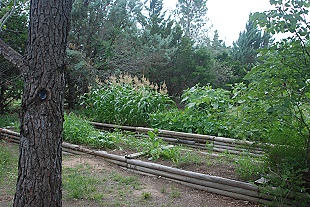
This is the garden from the east; the near bed had radishes in it and still has some carrots; to the right is a huge (HUGE) Mexican oregano plant from previous years. We did not get the winter stuff in on time because of the severe drought and water use restrictions. The next bed has corn on both ends and beans and sunflowers in the middle.
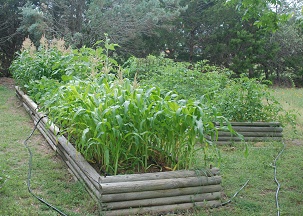
From the north, looking SW: this is the corn & beans planter, with the tomato planter to the right. The corn at this end is not as far along as at the other. Right of the tomato planter is the wildflower garden.
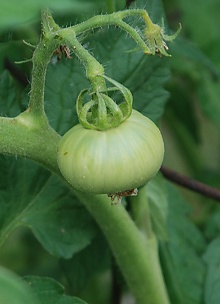
Just one of the green tomatoes. The bushes are huge and we didn’t get the kind of support in place that I like, but they’re tomato-ing away.
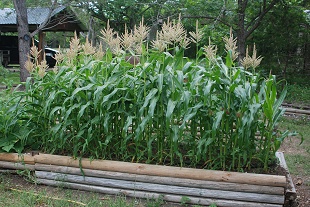
This is the most advanced corn. Although it’s not very tall, it’s flowering now.
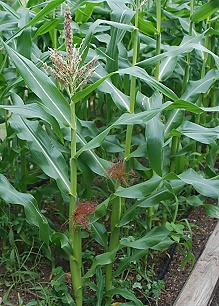
We’re hoping that we, and not the raccoons, will get some of the ears when they ripen.
We need to gutter the roof of this house (it was my mother’s, and is now where our son lives) so we will have rainwater for this garden and can worry less about restrictions on city water use.) In the past we’ve grown potatoes, lettuce, etc. in this garden and all we really need is reliable water to keep doing so.
Finally, a pretty from the lily pond that serves as a wildlife waterer and home for frogs, dragonflies, etc.
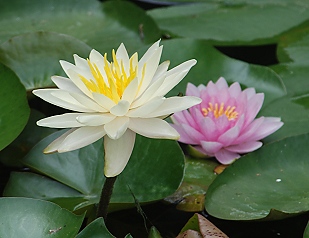
When you find these together, you just have to take a picture.
Comment by elizabeth — May 13, 2009 @ 10:40 pm
And today, the 13th, we had nice fresh green beans. Not quite enough for a meal, so we crunched them raw. Delicious!
Comment by Adrianne Middleton — May 14, 2009 @ 11:24 am
E, when you decided to rehab your land, how did you start? There is a plot of ground that was horribly overgrazed 15 years ago, and never has grown anything since. But this year they’re grading it for some development or another, and with the grading and the spring rains, it’s turned green for the first time I can remember.
Thanks!
Comment by elizabeth — May 14, 2009 @ 11:55 am
Step one: remove the cattle. Providentially, this happened in February, and it had started raining, so the cool-weather forbs were up but hadn’t been eaten (not big enough) and in the rain they took off.
Step two: erosion control. We picked up rocks and more rocks and lots more rocks, and took them to places where erosion was happening. Built check dams first, and then gabions all through that year.
Step three: actually began before we owned the land, with permission of then then-owner–cleared invasive Ashe juniper off the main grassland. (It invades when grass is overgrazed, down here.)
Step four: in areas that were just about barren but for noxious invasives, mowed them and mowed them and mowed them. As better plants moved in, cut the # of mowings back. The goal was to get *some* grass started and keep the noxious ones no higher than the grass (so they couldn’t canopy and cut the grass off.)
Grading and rain will start some green–but mostly disturbed-ground plants. It loosens the soil at first (then compacts it, but if you’re lucky you get rain on it before it compacts.)
Comment by Adrianne Middleton — May 14, 2009 @ 1:39 pm
Interesting. This property hasn’t had animals in years. I think goats overgrazed it. It never grew enough to mow. It was almost completely barren, which is a stark contrast to the lovely grassy horse pasture across the road.
No doubt your little check dams would have helped this place. It’s more of our infamous clay, and quite hilly. So anything to hold the water would have been a bonus.
A
Comment by elizabeth — May 14, 2009 @ 8:51 pm
My applied ecology prof said the key to managing land was managing water. The ideal was to have no runoff, or any runoff be crystal clear….to have water soak in and nourish plants and restore the water table. As the water table comes up, springs begin to flow, and as springs flow, streamflow evens out. “Manage your water and everything else will take care of itself,” he said more than once. Maybe not quite, where land’s been actively harmed–“goated out” is what we call what happened to the land you described–but you can’t do good with other management if you aren’t actively managing the water.
Comment by Adrianne Middleton — May 15, 2009 @ 6:53 am
Goated out is a new term for me. Thanks. I had noticed that goats are particularly bad about eating everything.
A
Comment by elizabeth — May 15, 2009 @ 7:51 am
When an idiot buys a piece of land around here, and wants it to look “parked” (only the oak and elm scrub-trees, and clear underneath) someone tells him to get some goats, and he does, and the goats eat everything they can reach, standing up on their hind legs to prune the trees to that height (the height of a goat on its hind legs.) That’s called “goating it out.” Goated-out land has compacted soil (because goating out a piece of land requires that you overstock it with goats and those little hooves are exactly like the “sheep’s foot roller” used to compact soil for highway construction. Goated out land has just about nothing that a goat can reach the leaves of. Goats eat brush–they’ll eat grass, but their natural diet is coarse weeds and woody plants.
Livestock is destructive when overstocked but goats and sheep are the ones that take it that last quarter mile down the road to barren.
Comment by elizabeth — May 17, 2009 @ 10:06 pm
CORN! Today we had corn and beans. Only one ear, and it wasn’t really ripe, but we were checking…as Richard said, there was more corn on that one ear than we planted.